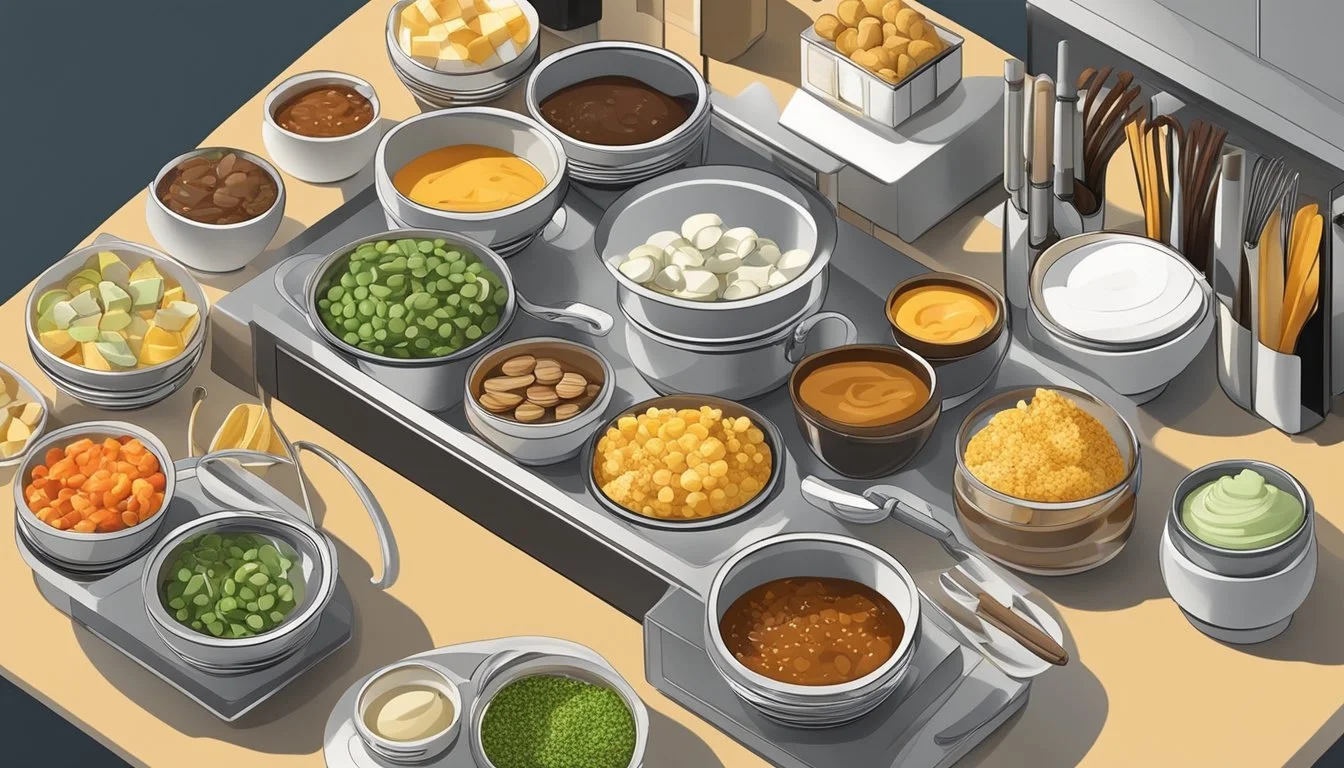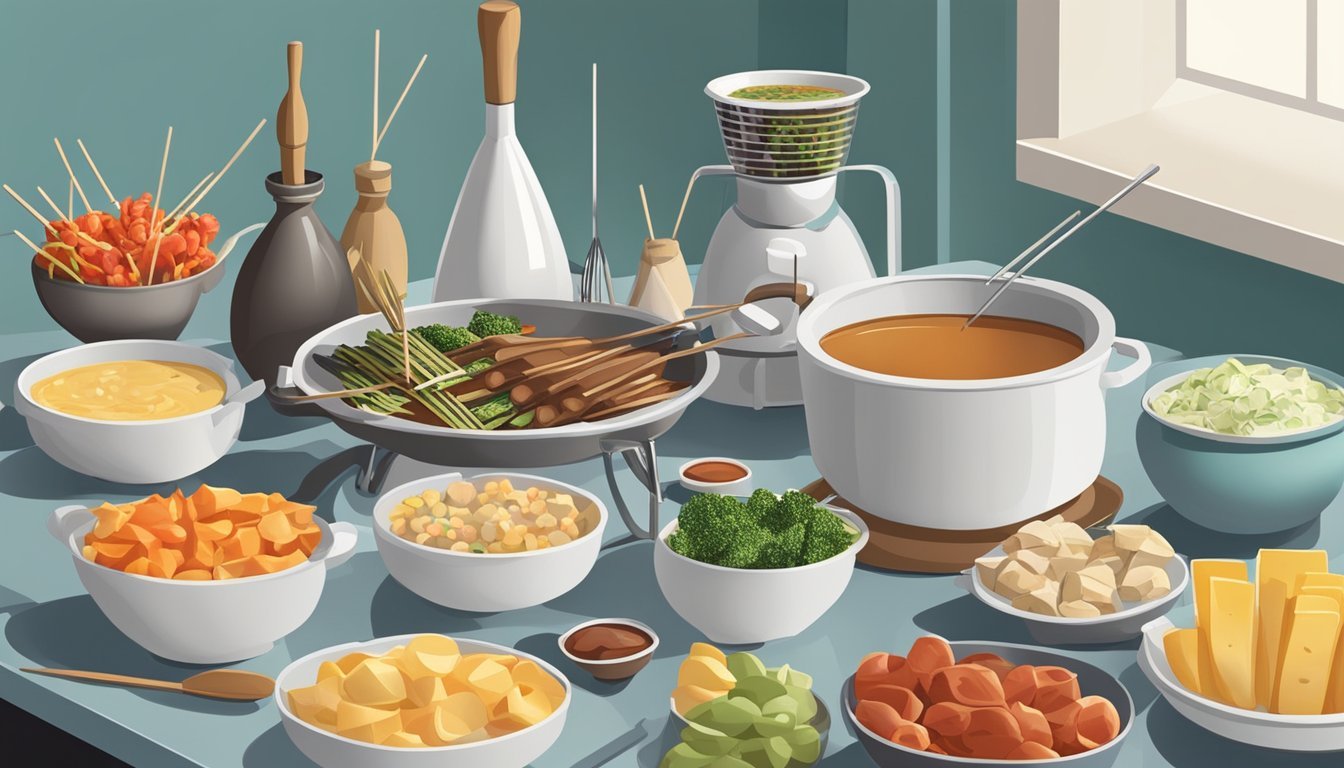How to Create an Organized Kitchen Fondue Station
Your Ultimate Guide
Creating an organized kitchen fondue station is an excellent way to present a dining experience that blends entertainment with delicious cuisine. It begins with a well-thought-out plan that factors in both the type and volume of fondue being served, whether it's a rich cheese blend or a decadent chocolate treat. By considering the main components of a fondue meal and space within the kitchen, hosts can develop a streamlined fondue station that encourages a smooth flow for guests and minimizes clutter.
An efficient fondue station is designed with accessibility and functionality at its core. This involves prepping dippables in advance, ensuring that they are cut to the right size for easy dipping and arranged in a way that guests can reach without stretching across the table. It's crucial for the fondue pots to be placed at the center of the station, which may feature multiple pots if various types of fondue are offered, including cheese, broth, or chocolate.
Further enhancing the fondue station calls for attention to detail and a nod to aesthetic appeal without sacrificing practicality. Labels for different dippables, food-safe skewers, and color-coded forks prevent mix-ups and keep the event flowing seamlessly. Kitchen organization techniques apply here, with every element positioned within arm's reach to facilitate movement and conversation as guests mingle and savor the interactive meal. With the fondue station as the focal point, the kitchen becomes an inviting space for gathering, sharing, and indulgence.
Understanding Fondue
Fondue is a communal pot of melted cheese, chocolate, or other mixtures, into which guests dip bread, vegetables, or fruit using long-stemmed forks. Its versatility and the shared dining experience make it a favorite for gatherings.
History of Fondue
Fondue originated in Switzerland in the 18th century as a means to utilize aged cheeses and hardened bread. The melted cheese dish was later popularized as a Swiss national dish by the Swiss Cheese Union in the 1930s. It became a global sensation in the 1960s.
Types of Fondue
There are primarily two popular types of fondue: cheese fondue and chocolate fondue. Cheese fondue consists of a pot of melted cheese, wine, and seasoning into which people dip pieces of bread or vegetables. Chocolate fondue, on the other hand, is a pot of melted chocolate often served with fruits, cakes, or marshmallows for dipping. Besides these, there are also other variations, including:
Oil or Broth Fondue: Used for cooking meats and seafood.
Sweet Fondue: Other dessert versions include caramel and marshmallow.
Fondue Essentials
To enjoy fondue, the following essential items are necessary:
Fondue Pot: A special pot made of ceramic for cheese or chocolate, and metal for oil or broth fondues.
Heat Source: Candles, gel burners, or electric heaters are used to keep the fondue at the right temperature.
Fondue Forks: Long forks used to dip and hold the food items without getting too close to the heat.
Dippers: Bite-sized foods such as bread cubes, apple slices, vegetables, or meat pieces.
Recipes: It's important to have the right fondue recipe which often includes a mix of different cheeses or high-quality chocolate along with the correct thinners such as wine or cream to ensure a smooth dipping consistency.
Designing Your Kitchen Fondue Station
Creating an organized kitchen fondue station incorporates strategic location choice, efficient use of countertop space, and the selection of an appropriate fondue pot that suits the overall kitchen design.
Selecting the Right Location
The location of the fondue station is paramount to its functionality and flow. One should aim for a spot that is accessible yet safe, avoiding high-traffic areas to prevent accidents. Near the dining area is ideal for ease of service, while proximity to small appliances like a stovetop can be beneficial for initial meal preparation. Adequate lighting is crucial, and if available, a spot under a kitchen island pendant light can be both functional and aesthetically pleasing.
Optimizing Countertop Space
The countertop space should provide enough room for the fondue pot and accompanying dishes. Using a marble countertop not only adds a touch of elegance but also provides a durable and heat-resistant surface. It is important to clear the space of clutter, reserving it solely for fondue-related items. This can include:
A fondue pot with its stand and burner
Plates for guests
Serving utensils
Dipping ingredients
If space is limited, consider a collapsible stand or a multi-level server to maximize vertical space.
Choosing Your Fondue Pot
The fondue pot is the centerpiece of the station and should align with the kitchen's design ethos. When choosing a fondue pot, one should consider:
Material: Ceramic is great for cheese and chocolate while metal pots are preferred for meat.
Size: Ensure it's large enough for your party size but not overly cumbersome.
Heat Source: A gel burner may offer cleaner handling compared to liquid fuel.
Maintenance: Look for pots that are easy to clean and maintain, preferably dishwasher safe.
A well-chosen fondue pot not only cooks efficiently but also contributes to the visual appeal of your kitchen fondue station.
Organizing Essentials
Creating a smoothly functioning fondue station requires strategic organization that considers accessibility and efficiency. Properly storing equipment, arranging dippers, and utilizing lazy susans or trays are critical for a successful fondue experience.
Storing Fondue Equipment
Essential fondue equipment, including the fondue pot, burner, and forks, needs to be stored safely and within reach. Fondue pots should be placed on shelves or in cabinets that are easily accessed, yet away from high-traffic areas to avoid accidents. Burners and fondue forks can be arranged in drawer organizers or dedicated storage containers. It is wise to keep all dry ingredients for the fondue nearby, in airtight containers to maintain freshness.
Arranging Dippers and Ingredients
Dippers such as bread cubes, vegetables, and meats should be prepped ahead of time and stored in clear, labeled containers in the refrigerator or at room temperature, depending on their needs. Fresh ingredients require refrigeration, while dry items like bread cubes can be kept on the countertop or in a pantry. A well-organized station encourages guests to navigate and enjoy the fondue experience seamlessly.
Setting Up a Lazy Susan or Tray
Incorporating a Lazy Susan or large tray into the fondue station maximizes accessibility and creates a communal feel. Place the Lazy Susan in the center of the table with an array of condiments, sauces, and additional dippers. The rotating functionality allows for easy sharing without the need to reach across the table, thus keeping the experience pleasant and organized. For stations without a Lazy Susan, a sizable, stable tray can serve a similar purpose, allowing for dippers and sauces to be arranged neatly around the fondue pot.
Hosting a Fondue Party
Hosting a fondue party involves meticulous planning, creating a soothing atmosphere, and orchestrating an interactive dining experience. Success hinges on a host's attention to detail from the menu selection to the ambient settings.
Planning the Menu
The foundation of a fondue party rests on a well-crafted menu. Cheese fondue recipes often call for a blend of Alpine cheeses like Gruyère or Comté, melted in white wine, seasoned with nutmeg, and sometimes enhanced with a splash of Kirsch. The fondue should be kept warm throughout the event, preferably using a gel burner for convenience.
Dipping sauces and an assortment of bite-size dipping items are essential. Guests should have a variety of options such as bread cubes, vegetables, and cooked meats. It's important to add cheeses into the liquid mixture incrementally, stirring constantly for a smooth texture.
Creating an Atmosphere
The ambiance of a fondue party can be enriched by careful selection of music, candles, and decorations that match the intended mood of the evening. An inviting atmosphere encourages guests to relax and enjoy the communal dining experience. Lighting should be intimate but sufficient for guests to see what they are eating, and music should be at a level that allows for comfortable conversation.
Interactive Fondue Experience
An organized kitchen fondue station invites guests to engage with their food. Clear instructions on fondue etiquette—such as no double-dipping and using separate forks for dipping and eating—maintain hygiene and order. Providing color-coded or personalized forks can prevent mix-ups at the pot. Encouraging guests to participate not only in the dipping but also in the preparation of their plates fosters an interactive, enjoyable experience.
Safety Measures
Creating an organized kitchen fondue station involves careful consideration of safety measures to prevent accidents and ensure an enjoyable experience.
Managing the Heat Source
It is imperative to select an appropriate heat source for the fondue station. Sterno cans or electric fondue pots are commonly used and should be placed on a stable, heat-resistant surface away from flammable materials. Fuel levels should be monitored and refilled only when the heat source is completely cool to prevent the risk of ignition. If using electric fondue pots, one should ensure that the cord is not in a position where someone could trip over it.
Do:
Use a stable, heat-resistant surface.
Cool completely before refueling.
Ensure cords are tucked away safely.
Don't:
Overfill the fondue pot with oil or cheese.
Leave the heat source unattended.
Place near flammable materials.
Using Fondue Forks Safely
Fondue forks are essential for a fondue station but come with risks, such as burns or punctures. Guests should use the forks only for dipping and should not eat directly from them to avoid burns. Each person should have a personal plate to transfer the dipped items from the fork, allowing them to cool sufficiently before consuming.
Do:
Provide individual plates for cooling dipped items.
Instruct guests to use the forks only for dipping, not eating.
Don't:
Overcrowd the pot with forks.
Leave forks unattended or with the sharp ends exposed.
Additional Kitchen Stations
In designing an efficient kitchen layout, specific stations dedicated to frequent tasks can streamline workflows. The coffee station and baking station are prime examples where one can integrate functionality with accessibility.
Coffee Station Essentials
A well-appointed coffee station includes a coffee maker, central to its operation. Adjacent to it, one should organize a selection of mugs, ideally hung on hooks or displayed on a shelf for easy access. To complement the coffee maker, a shelf or drawer should house coffee, filters, and coffee accessories like a grinder, frother, and spoons:
Coffee Maker: Choose a model that suits your daily needs, whether for single servings or large batches.
Mugs: Store in an array close to the coffee maker.
Accessories:
Grinder: For fresh bean-to-cup coffee.
Frother: For adding a creamy finish to beverages.
Spoons and other utensils: Neatly arranged for convenience.
Building a Baking Station
A baking station centers around the stand mixer, an indispensable tool for any baker. Surrounding this appliance, one should place ingredients and utensils within arm's reach on the countertop or in nearby storage. Include measuring cups, spatulas, and mixing bowls in a logical and accessible layout:
Stand Mixer: Positioned as the focal point for easy use.
Baking Tools: Measuring cups, spatulas, and mixing bowls stored within reach.
Storage Solutions:
Ingredient Containers: Clearly labeled for quick identification.
Utensil Holder: Organize spatulas and whisks for immediate access.
Both the coffee and baking stations benefit from having dedicated spaces to not only perform their intended functions but also to add to the kitchen's overall aesthetic.







